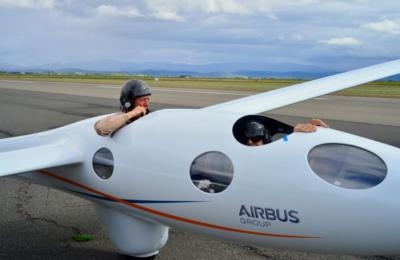Tue, May 10, 2016
Preparing For Move To Argentina Later This Year To Attempt World-Record Breaking Flights
Airbus Group CEO Tom Enders on Saturday joined the all-volunteer Airbus Perlan Mission II team in the role of co-pilot on the latest test flight of the Perlan 2 glider, the world's first engineless aircraft designed to reach the edge of space.

The flight was led by the project's chief pilot Jim Payne at Minden-Tahoe Municipal Airport. Enders also received a full briefing on the experimental aircraft's pressurization and life support systems, which will be critical to mission safety and success when the team attempts to soar at record-breaking altitudes later this year in Argentina.
An experienced helicopter pilot and an aviation enthusiast, Enders also took the controls of the glider to experience the unique handling qualities of an aircraft optimized to fly in air almost as thin as the atmosphere on Mars.
"Experiencing the Perlan 2 glider in flight was truly remarkable," said Enders (pictured below exiting the glider). "Airbus Perlan Mission II is all about pushing the boundaries of innovation, refining our understanding of our environment and climate change, and inspiring a new generation of aerospace pioneers. We're honored to see this dedicated team of volunteers carry our name on a journey that will eventually take them to the edge of space."

The Perlan 2 is a pressurized sailplane designed to ride air currents that, in certain mountainous regions near the north and south poles, can reach into the stratosphere. Last September, the Perlan 2 successfully achieved its first flight in Redmond, Oregon, making news around the world.
The Airbus Perlan Mission II team will be relocating its operations to the Patagonia area of Argentina this summer, where conditions will allow the team to begin higher-altitude flights that will ultimately take them as high as 90,000 feet, yielding new discoveries in climate change and space exploration. Despite having no engine, the glider's true flight speed at that altitude will be more than 400 mph and the air density will be less than two percent of what it is at sea level. The crew will breathe pure oxygen provided by a rebreather system, similar to what astronauts use in space.
(Images provided with Airbus news release)
More News
From 2023 (YouTube Version): Legacy of a Titan Robert (Bob) Anderson Hoover was a fighter pilot, test pilot, flight instructor, and air show superstar. More so, Bob Hoover was an i>[...]
Get The Latest in Aviation News NOW on Instagram Are you on Instagram yet? It's been around for a few years, quietly picking up traction mostly thanks to everybody's new obsession >[...]
Aero Linx: B-52H Stratofortress The B-52H Stratofortress is a long-range, heavy bomber that can perform a variety of missions. The bomber is capable of flying at high subsonic spee>[...]
Altimeter Setting The barometric pressure reading used to adjust a pressure altimeter for variations in existing atmospheric pressure or to the standard altimeter setting (29.92).>[...]
"Knowing that we play an active part in bettering people's lives is extremely rewarding. My team and I are very thankful for the opportunity to be here and to help in any way we ca>[...]
 Classic Aero-TV: Remembering Bob Hoover
Classic Aero-TV: Remembering Bob Hoover ANN FAQ: Follow Us On Instagram!
ANN FAQ: Follow Us On Instagram! ANN's Daily Aero-Linx (05.15.24)
ANN's Daily Aero-Linx (05.15.24) ANN's Daily Aero-Term (05.15.24):Altimeter Setting
ANN's Daily Aero-Term (05.15.24):Altimeter Setting Aero-News: Quote of the Day (05.16.24)
Aero-News: Quote of the Day (05.16.24)




